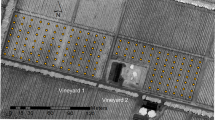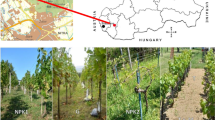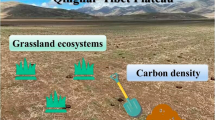Abstract
Topography and vegetation have a significant role in soil development in different ecosystems. Interactions between soil and landforms help to understand the pedogenic processes and soil variability. The present study assessed the impact of various landforms and vegetation on pedological variability along the toposequence of the eastern coastal plain. We characterized 46 soil profiles from five landforms, viz., foothills, upland, alluvial plains, coastal plains, and sandbars and performed factor analysis. The frequency distribution of the soil properties was significantly skewed with each other’s. Soils are classified into three orders: Alfisols, Inceptisols, and Entisols from hills to sandbars. The soils were characterized by clay (2.50–65.8%), AWC (4.0–28.0%), pH (5.40–9.40), EC (0.03–5.60 dSm−1), OC (0.01–1.13%), CEC (1.0-31.60 cmol (p+) kg−1), BS (57–95%) and ESP (0.54–27.8%). Whereas alluvial plain soils are rich in clay and organic carbon, foothill and upland soils experience severe to moderate soil erosion, leading to the leaching of basic cations. Coastal plains face regular seawater intrusion and flooding, causing excess deposition of salts, which alter the soil pedogenic process under different landforms and land use. Soil pH, EC, clay, CEC and ESP significantly influenced the paddy yield in alluvial and coastal plains landforms. Development of landform and soil relationships concerning land uses in coastal regions helps to identify factors involved in soil development, pedogenic processes and crop productivity.




Similar content being viewed by others
References
Abdelfattah MA (2013) Pedogenesis, land management and soil classification in hyper-arid environments: results and implications from a case study in the United Arab Emirates. Soil Use Manag 29(2):279–294
Ali A, Esayas A, Beyene S (2010) Characterizing soils of Delbo Wegene watershed, Wolaita Zone, Southern Ethiopia for planning appropriate land management. J Soil Sci Environ 1(8):184–199
Bandyopadhyay AK, Bhargava GP, Bandyopadhyay BK (1984) Coastal saline soils of orissa, CSSRI, RRS, Canning Town, West Bengal, 56
Bhattacharyya T, Sarkar D, Pal DK, Mandal C, Baruah U, Telpande B, Vaidya PH (2010) Soil information system for resource management-Tripura as a case study. Curr Sci 1208–1217
Boling AA, Tuong TP, Suganda H, Konboon Y, Harnpichitvitaya D, Bouman BAM, Franco DT (2008) The effect of toposequence position on soil properties, hydrology, and yield of rainfed lowland rice in Southeast Asia. Field Crops Res 106(1):22–33. https://doi.org/10.1016/j.fcr.2007.10.013
Buol SW, Southard RJ, Graham RC, McDaniel PA (2003) Soil genesis and classification, 5th edn. Iowa State University Pess-Blackwell, Ames IA
Choudhury SG, Srivastava S, Singh R, Chaudhari SK, Sharma DK, Singh SK, Sarkar D (2014) Tillage and residue management effects on soil aggregation, organic carbon dynamics and yield attribute in rice–wheat cropping system under reclaimed sodic soil. Soil Tillage res 136:76–83
IPCC (2001) Climate change 2001: the scientific basis: contribution of working group I to the third assessment report of the intergovernmental panel on climate change
Cullum C, Brierley G, Perry GL, Witkowski ET (2017) Landscape archetypes for ecological classification and mapping: the virtue of vagueness. Prog Phys Geogr 41(1):95–123
De Neve S, Van de Steene J, Hartmann R, Hofman G (2000) Using time domain reflectometry for monitoring mineralization of nitrogen from soil organic matter. Eur J Soil Sci 51(2):295–304. https://doi.org/10.1016/S0378-4290(99)00047-7
Dessalegn D, Beyene S, Ram N, Walley F, Gala TS (2014) Effects of topography and land use on soil characteristics along the toposequence of Ele watershed in southern Ethiopia. CATENA 115:47–54
Florinsky IV (2012) Digital elevation models. Digital terrain analysis in soil science and geology. Elsevier Inc, pp 31–41
Gangopadhyay SK, Bhattacharyya T, Sarkar D (2015) Hydromorphic soils of Tripura: their pedogenesis and characteristics. Curr Sci 984–993
Gessler PE, Chadwick OA, Chamran F, Althouse L, Holmes K (2000) Modeling soil–landscape and ecosystem properties using terrain attributes. Soil Sci Soc Am J 64(6):2046–2056
Hassan AM, Raji BA, Malgwi WB, Agbenin JO (2015) The basaltic soils of Plateau State, Nigeria: Properties, classification and management practices. J Soil Sci Environ 6(1):1–8
Huggett RJ (1976) Lateral translocation of soil plasma through a small valley basin in the Northaw Great Wood, Hertfordshire. Earth Surf Process 1(2):99–109. https://doi.org/10.1002/esp.3290010202
Inthavong T, Tsubo M, Fukai S (2012) Soil clay content, rainfall, and toposequence positions determining spatial variation in field water availability as estimated by a water balance model for rainfed lowland rice. Crop Pasture Sci 63(6):529–538. https://doi.org/10.1071/CP12108
Iticha B, Takele C (2018) Soil–landscape variability: mapping and building detail information for soil management. Soil Use Manag 34(1):111–123. https://doi.org/10.1111/sum.12404
Keshavarz P, Malakouti M, Karimian N, Fotovat A (2006) The effects of salinity on extractability and chemical fractions of zinc in selected calcareous soils of Iran. J Agric Sci Technol 8:181–190
Khan ZH, Hussain MS, Ottner F (2012) Morphogenesis of three surface? Water Gley soils from the Meghna Floodplain of Bangladesh. Dhaka University. J Biol Sci 21(1):17–27
Klute A (1986) Water retention: laboratory methods. Methods Soil Anal: Part 1 Phys Mineralogical Methods 5:635–662
Kosmas C, Gerontidis S, Marathianou M (2000) The effect of land use change on soils and vegetation over various lithological formations on Lesvos (Greece). CATENA 40(1):51–68
Lalitha M, Kalaiselvi B, Dharumarajan S, Anil Kumar KS, Ramesh Kumar SC, Srinivasan R, Ramamurthy V, Rajendra H (2023) Determining soil quality indicators for alluvial plains in the semi-arid tropics. Soil Use Manag. https://doi.org/10.1111/sum.12929
Manik SM, Pengilley G, Dean G, Field B, Shabala S, Zhou M (2019) Soil and crop management practices to minimize the impact of waterlogging on crop productivity. Front Plant Sci 140. https://doi.org/10.3389/fpls.2019.00140
Maniyunda LM, Gwari MG (2014) Soils development on a toposequence on loessial deposit in Northern Guinea Savanna, Nigeria. J Agric Biol Sci 9(3):110–116
McBratney AB, Santos MM, Minasny B (2003) On digital soil mapping. Geoderma 117(1–2):3–52
Mohiuddin M, Irshad M, Sher S, Hayat F, Ashraf A, Masood S, Bibi S, Ali J, Waseem M (2022) Relationship of selected Soil properties with the micronutrients in Salt-affected soils. Land 11:845. https://doi.org/10.3390/land11060845
Momtaz HR, Jafarzadeh AA, Torabi H, Oustan S, Samadi A, Davatgar N, Gilkes RJ (2009) An assessment of the variation in soil properties within and between landform in the Amol region, Iran. Geoderma 149(1–2):10–18. https://doi.org/10.1016/j.geoderma.2008.11.016
Moore ID, Gessler PE, Nielsen GAE, Peterson GA (1993) Soil attribute prediction using terrain analysis. Soil Sci Soc Am J 57(2):443–452
Mulla DJ, McBratney AB (2001) Soil spatial variability. Soil physics companion. CRC Press, Boca Raton, pp 343 – 77
Negasa T, Ketema H, Legesse A, Sisay M, Temesgen H (2017) Variation in soil properties under different land use types managed by smallholder farmers along the toposequence in southern Ethiopia. Geoderma 290:40–50. https://doi.org/10.1016/j.geoderma.2016.11.021
Oku E, Essoka A, Thomas E (2010) Variability in soil properties along an Udalf toposequence in the humid forest zone of Nigeria. Agric Nat Resour 44(4):564–573
Padhan D, Rout PP, Sahoo T (2015) Surface and sub-surface distribution of available potassium in rice growing soils under western central tableland agro-climatic zones of Odisha. J Agroecol Nat Resour Manag 2(5):365–368
Page AL, Miller RH, Keeney DR, Baker DE, Roscoe Ellis JR, Rhoades JD (1982) Methods of soil analysis-chemical and microbiology properties. SSSA Inc, Mad WI USA
Pal DK, Wani SP, Sahrawat KL, Srivastava P (2014) Red ferruginous soils of tropical Indian environments: a review of the pedogenic processes and its implications for edaphology. CATENA 121:260–278
Pilesjö P, Thylén L, Persson A (2005) Topographical data for delineation of agricultural management zones. In Stafford J (Ed) Proceedings of the Fifth European Conference on Precision Agriculture 819–826
Piper CS (1966) Soil and plant analysis. Hans Publishers, Bombay, India
Ponnamperuma FN (1985) Chemnical kinetics of wetland rice soils relative to soil fertility in wetland soils: characterization, classification, and utility. International Rice Research Institute, Manila, pp 71–90
Reza SK, Baruah U, Nayak DC, Dutta D, Singh SK (2018) Effects of land-use on soil physical, chemical and microbial properties in humid subtropical Northeastern India. Natl Acad Sci Lett 41:141–145
Reza SK, Ray P, Alam NM, Mukhopadhyay S, Singh SK, Ray SK (2022) Soil properties-landform relationship in Purvanchal range of Tripura, northeastern India: an implication of pedogenesis. J Geol Soc India 98(3):402–410. https://doi.org/10.1007/s12594-022-1992-3
Saint-Laurent D, Paradis R, Drouin A, Gervais-Beaulac V (2016) Impacts of floods on organic carbon concentrations in alluvial soils along hydrological gradients using a digital elevation model (DEM). Water 8(5):208
Schollenberger CJ, Simon RH (1945) Determination of exchange capacity and exchangeable bases in soil ammonium acetate method. Soil Sci 59:13–24. https://doi.org/10.1097/00010694-194501000-00004
Sheleme B (2011) Characterization of soils along a toposequence in Gununo area, southern Ethiopia. J Sci Dev 1(1):31–41
Shukla MK, Lal R, Ebinger M (2006) Determining soil quality indicators by factor analysis. Soil Tillage res 87(2):194–204. https://doi.org/10.1016/j.still.2005.03.011
Singh IS, Agrawal HP (2005) Characterization, genesis and classification of rice soils of eastern region of Varanasi, Uttar Pradesh. Agropedology 15(1):29–38
Soil Survey Staff (2003) Keys to soil taxonomy. 9th edn. United States Department of Agriculture, United States Department of Agriculture Natural Resources Conservation Service, p 322
Srinivasan R, Singh SK, Nayak DC, Dharumarajan S (2017) Assessment of soil properties and nutrients status in three horticultural land use system of coastal Odisha, India. Int J Bio-Resour Stress Manag 8(1):33–40
Srinivasan R, Hegde R, Thilagam VK, Kumar SN (2021) Soil-site characterization on crop productivity in Alfisols of Eastern Ghats of Tamil Nadu, India. J Soil Water Conserv 20(4):355–364. https://doi.org/10.5958/2455-7145.2021.00045.X
Srinivasan R, Nayak DC, Gobinath R, Kumar SN, Nageswara Rao DVK, Singh SK (2022) Consequential rice crop response to resultant soil properties in a toposequence in eastern coastal plain of Odisha, India. Model Earth Syst Environ 1–16. https://doi.org/10.1007/s40808-021-01216-2
Soil Survey Staff (2014) Keys to soil taxonomy. 12th edn. USDA-Natural Resources Conservation Service, Washington DC
Sumner ME, Miller WP (1996) Cation exchange capacity and exchange coefficients. Methods Soil Anal: Part 3 Chem Methods 5:1201–1229
Świtoniak M (2014) Use of soil profile truncation to estimate influence of accelerated erosion on soil cover transformation in young morainic landscapes, North-Eastern Poland. CATENA 116:173–184 (j. Catena.2013.12.015)
Tuong TP, Kam SP, Wade L, Pandey S, Bouman BAM, Hardy B (Eds.) (2000) Characterizing and understanding rainfed environments. Proceedings of the International Workshop on Characterizing and Understanding Rainfed Environments. 5–9 December 1999, Bali, Indonesia. IRRI, Los Baños, Philippines
Vasu D, Singh SK, Tiwary P, Chandran P, Ray SK, Duraisami VP (2016) Pedogenic processes and soil–landform relationships for identification of yield-limiting soil properties. Soil Res 55(3):273–284
Walkley A, Black IA (1934) An examination of the Degtjareff method for determining soil organic matter, and a proposed modification of the chromic acid titration method. Soil Sci 37(1):29–38
Wilding LP (1985) Spatial variability: its documentation, accommodation, and implication to soil surveys. In Soil spatial Variability. DR. Nielsen and J. Bouma (eds). Pudoc, Wageningen, The Netherlands, pp 166–194
Yost RS, Uehara G, Fox RL (1982) Geostatistical analysis of soil chemical properties of large land areas. I. Semi-variograms. Soil Sci Soc Am J 46(5):1028–1032
Zuo X, Zhao X, Zhao H, Zhang T, Guo Y, Li Y, Huang Y (2009) Spatial heterogeneity of soil properties and vegetation–soil relationships following vegetation restoration of mobile dunes in Horqin Sandy Land, Northern China. Plant soil 318:153–167. https://doi.org/10.1007/s11104-008-9826-7
Acknowledgements
The authors acknowledge the financial support extended by Indian Council of Agricultural Research (ICAR), New Delhi, India for carrying out the study. The authors thank the editor and the anonymous reviewers for their suggestions for improving the quality of the manuscript.
Author information
Authors and Affiliations
Corresponding author
Ethics declarations
Conflict of interest
The authors have declared that no conflict of interest exists.
Additional information
Publisher’s Note
Springer Nature remains neutral with regard to jurisdictional claims in published maps and institutional affiliations.
Rights and permissions
Springer Nature or its licensor (e.g. a society or other partner) holds exclusive rights to this article under a publishing agreement with the author(s) or other rightsholder(s); author self-archiving of the accepted manuscript version of this article is solely governed by the terms of such publishing agreement and applicable law.
About this article
Cite this article
Ramasamy, S., Manickam, L., Padua, S. et al. Effect of landforms and vegetations on pedological variability and crop yield along the toposequence of Eastern Coastal Plain of Odisha, India. J Coast Conserv 28, 21 (2024). https://doi.org/10.1007/s11852-023-01018-x
Received:
Revised:
Accepted:
Published:
DOI: https://doi.org/10.1007/s11852-023-01018-x




